Analysis of the Spatial and Temporal Variability and Factors Influencing the Ecological Resilience in the Urban Agglomeration on the Northern Slope of Tianshan Mountain
Abstract
:1. Introduction
2. Study Area, Data Sources, and Methods
2.1. Study Area
2.2. Data Collection and Preprocessing
2.3. Method
2.3.1. Ecological Resilience Measurement Model
2.3.2. Center of Gravity-Standard Deviation Ellipse
2.3.3. Detecting the Factors Driving Ecological Resilience
3. Results
3.1. Temporal Change Characteristics of the Ecological Resilience of the UANST
3.2. Spatial Evolutionary Characteristics of the Ecological Resilience of the UANST
3.3. Analysis of Factors Influencing the Ecological Resilience of the UANST
4. Discussion and Conclusions
Author Contributions
Funding
Institutional Review Board Statement
Informed Consent Statement
Data Availability Statement
Conflicts of Interest
References
- Chandler, D.; Grove, K.; Wakefield, S. Resilience in the Anthropocene; Routledge: London, UK, 2020; pp. 22–23. [Google Scholar]
- Holling, C.S. Resilience and Stability of Ecological Systems. Annu. Rev. Ecol. Syst. 1973, 4, 1–23. [Google Scholar] [CrossRef] [Green Version]
- Pimm, S.L. The complexity and stability of ecosystems. Nature 1984, 307, 321–326. [Google Scholar] [CrossRef]
- Gunderson, L.H. Ecological Resilience—In Theory and Application. Annu. Rev. Ecol. Syst. 2000, 31, 425–439. [Google Scholar] [CrossRef] [Green Version]
- Holling, C.S. Engineering resilience versus ecological resilience. Eng. Ecol. Constraints 1996, 31, 32. [Google Scholar]
- Holling, C.S. Understanding the Complexity of Economic, Ecological, and Social Systems. Ecosystems 2001, 4, 390–405. [Google Scholar] [CrossRef]
- Yuan, Q.; Meng, F.; Li, F.; Liu, G.; Yang, Z. A Conceptual Framework for Enhancing Urban Resilience with Green and Blue Infrastructure from the Perspective of Food-Energy-Water Nexus. Urban Dev. Stud. 2022, 29, 20–27. [Google Scholar]
- Xu, Y.; Li, G.; Cui, S.; Xu, Y.; Pan, J.; Tong, N.; Xu, J.; Zhu, Y. Review and Perspective on Resilience Science: From Ecological Theory to Urban Practice. Acta Ecol. Sin. 2018, 38, 5297–5304. [Google Scholar]
- Shen, Q. Research on Resilient Thinking and Urban Ecological Planning. Shanghai Urban Plan. Rev. 2018, 3, 1–7. [Google Scholar]
- Fang, C. Important progress and future direction of studies on China’s urban agglomerations. J. Geogr. Sci. 2015, 25, 1003–1024. [Google Scholar] [CrossRef] [Green Version]
- Feng, D.; Li, J.; Li, X.; Zhang, Z. The Effects of Urban Sprawl and Industrial Agglomeration on Environmental Efficiency: Evidence from the Beijing–Tianjin–Hebei Urban Agglomeration. Sustainability 2019, 11, 3042. [Google Scholar] [CrossRef] [Green Version]
- Zhao, Y.; Wang, S.; Zhou, C. Understanding the relation between urbanization and the eco-environment in China’s Yangtze River Delta using an improved EKC model and coupling analysis. Sci. Total Environ. 2016, 571, 862–875. [Google Scholar] [CrossRef]
- Kalnay, E.; Cai, M. Impact of urbanization and land-use change on climate. Nature 2003, 423, 528–531, Erratum in Nature 2003, 425, 102. [Google Scholar] [CrossRef]
- McMichael, A.J.; Woodruff, R.E.; Hales, S. Climate change and human health: Present and future risks. Lancet 2006, 367, 859–869. [Google Scholar] [CrossRef] [PubMed]
- Grimm, N.B.; Faeth, S.H.; Golubiewski, N.E.; Redman, C.L.; Wu, J.; Bai, X.; Briggs, J.M. Global Change and the Ecology of Cities. Science 2008, 319, 756–760. [Google Scholar] [CrossRef] [Green Version]
- Berdugo, M.; Delgado-Baquerizo, M.; Soliveres, S.; Hernández-Clemente, R.; Zhao, Y.; Gaitán, J.J.; Gross, N.; Saiz, H.; Maire, V.; Lehmann, A.; et al. Global ecosystem thresholds driven by aridity. Science 2020, 367, 787–790. [Google Scholar] [CrossRef] [PubMed] [Green Version]
- Fang, C.; Bao, C.; Ma, H. China’s Urban Agglomeration Development Report 2016; Science Press: Beijing, China, 2016; pp. 12–17. [Google Scholar]
- Fang, C.; Song, J.; Lin, X. Theory and Practice on the Sustainable Development of China’s Urban Agglomeration; Science Press: Beijing, China, 2010; pp. 35–43. [Google Scholar]
- Fang, C.; Gao, Q.; Zhang, X.; Cheng, W. Spatiotemporal characteristics of the expansion of an urban agglomeration and its effect on the eco-environment: Case study on the northern slope of the Tianshan Mountains. Sci. China Earth Sci. 2019, 62, 1461–1472. [Google Scholar] [CrossRef]
- Li, C.; Wang, R.; Cui, X.; Fang, W.; Yu, Y.; Qing, P.; Zhong, H.; Yang, X. Responses of vegetation spring phenology to climatic factors in Xinjiang, China. Ecol. Indic 2021, 124, 107286. [Google Scholar] [CrossRef]
- Zhang, Y.; Yang, D.; Zhang, X.; Deng, H. Regional structure and spatial morphology characteristics of oasis urban agglomer-ation in arid area -A case of urban agglomeration in northern slope of Tianshan Mountains, Northwest China. Chin. Geogr. Sci 2009, 19, 341. [Google Scholar] [CrossRef]
- Gao, C.; Lei, J. Economic contacts of urban agglomerations at northern slope of Tianshan Mountains. J. Arid Land Resour. Environ. 2011, 25, 24–30. [Google Scholar]
- Duan, Z.; Zhang, X.; Lei, J.; Wang, J. Study on urban multidimensional niche of urban agglomeration on northern slope of Tianshan Mountains. J. Univ. Chin. Acad. Sci. 2014, 31, 506–516. [Google Scholar]
- Ma, W.; Ding, J.; Wang, R.; Wang, J. Drivers of PM2.5 in the urban agglomeration on the northern slope of the Tianshan Mountains, China. Environ. Pollut. 2022, 309, 119777. [Google Scholar] [CrossRef]
- Yan, Y.; Chai, Z.; Yang, X.; Zibibula, S.; Yang, S. The temporal and spatial changes of the ecological environment quality of the urban agglomeration on the northern slope of Tianshan Mountain and the influencing factors. Ecol. Indic. 2021, 133, 108380. [Google Scholar]
- Zhang, L.; Fang, C.; Zhu, C.; Gao, Q. Ecosystem service trade-offs and identification of eco-optimal regions in urban agglom-erations in arid regions of China. J. Clean. Prod. 2022, 373, 133823. [Google Scholar] [CrossRef]
- Zhi, X.; Anfuding, G.; Yang, G.; Gong, P.; Wang, C.; Li, Y.; Li, X.; Li, P.; Liu, C.; Qiao, C.; et al. Evaluation of the Water Resource Carrying Capacity on the North Slope of the Tianshan Mountains, Northwest China. Sustainability 2022, 14, 1905. [Google Scholar] [CrossRef]
- Feng, Y.; Lee, C.-C.; Peng, D. Does regional integration improve economic resilience? Evidence from urban agglomerations in China. Sustain. Cities Soc. 2023, 88, 104273. [Google Scholar] [CrossRef]
- Zebardast, E. The Hybrid Factor Analysis and Analytic Network Process (F’ANP) model modified: Assessing community social resilience in Tehran metropolis. Sustain. Cities Soc. 2022, 86, 104127. [Google Scholar] [CrossRef]
- Vasilis, D.; Sonia, K. Ecological resilience: What to measure and how. Environ. Res. Lett 2022, 17, 043003. [Google Scholar]
- Carpenter, S.; Walker, B.; Anderies, J.; Abel, N. From metaphor to measurement: Resilience of what to what? Ecosystems 2001, 4, 765–781. [Google Scholar] [CrossRef]
- Grafton, R.Q.; Doyen, L.; Béné, C.; Borgomeo, E.; Brooks, K.; Chu, L.; Cumming, G.S.; Dixon, J.; Dovers, S.; Garrick, D.; et al. Realizing resilience for decision-making. Nat. Sustain. 2019, 2, 907–913. [Google Scholar] [CrossRef] [Green Version]
- Ren, X. A Comparative Study on Urban Ecological Resilience in the Pearl River Delta Region. J. Landsc. Res. 2019, 11, 54–58. [Google Scholar]
- Feng, X.; Xiu, C.; Bai, L.; Zhong, Y.; Wei, Y. Comprehensive evaluation of urban resilience based on the perspective of landscape pattern: A case study of Shenyang city. Cities 2020, 104, 102722. [Google Scholar] [CrossRef]
- Huang, L.; Wang, J.; Cheng, H. Spatiotemporal changes in ecological network resilience in the Shandong Peninsula urban agglomeration. J. Clean. Prod. 2022, 339, 130681. [Google Scholar] [CrossRef]
- Yuan, Y.; Bai, Z.; Zhang, J.; Xu, C. Increasing urban ecological resilience based on ecological security pattern: A case study in a resource-based city. Ecol. Eng. 2021, 175, 106486. [Google Scholar] [CrossRef]
- Zhang, Y.; Yang, Y.; Chen, Z.; Zhang, S. Multi-criteria assessment of the resilience of ecological function areas in China with a focus on ecological restoration. Ecol. Indic. 2020, 119, 106862. [Google Scholar] [CrossRef]
- Chang, C.; Li, X.; Dong, Z.; Tong, X.; Peng, L. A new model for describing the urban resilience considering adaptability, resistance and recovery. Saf. Sci. 2020, 128, 104756. [Google Scholar]
- Xia, C.; Dong, Z.; Chen, B. Spatiotemporal analysis and simulation of urban ecological resilience: A case study of Hangzhou. Acta Ecol. Sin. 2022, 42, 116–126. [Google Scholar]
- Mckinney, M. Urbanization, biodiversity, and conservation. BioScience 2002, 52, 883–890. [Google Scholar] [CrossRef]
- Forman, R.; Sperling, D.; Bissonette, J. Road Ecology: Science and Solutions; Island Press: New York, NY, USA, 2003. [Google Scholar]
- Zhong, X.; Yan, Q.; Li, G. Long time series night light data set of China (2000-2020). Glob. Chang. Data Repos. 2022, 1. [Google Scholar] [CrossRef]
- Wu, L.; Sun, C.; Fan, F. Estimating the Characteristic Spatiotemporal Variation in Habitat Quality Using the InVEST Model—A Case Study from Guangdong–Hong Kong–Macao Greater Bay Area. Remote. Sens. 2021, 13, 1008. [Google Scholar] [CrossRef]
- Costanza, R.; d’Arge, R.; de Groot, R.; Farber, S.; Grasso, M.; Hannon, B.; Limburg, K.; Naeem, S.; O’Neill, R.V.; Paruelo, J.; et al. The value of the world’s ecosystem services and natural capital. Nature 1997, 387, 253–260. [Google Scholar] [CrossRef]
- Daily, G. The value of nature and the nature of value. Science 2000, 289, 395–396. [Google Scholar] [CrossRef] [Green Version]
- Egoh, B.; Rouget, M.; Reyers, B.; Knight, A.; Cowling, R.M.; van Jaarsveld, A.S.; Welz, A. Integrating ecosystem services into conservation assessments: A review. Ecol. Econ. 2007, 63, 714–721. [Google Scholar] [CrossRef]
- Lautenbach, S.; Kugel, C.; Lausch, A.; Seppelt, R. Analysis of historic changes in regional ecosystem service provisioning using land use data. Ecol. Indic. 2011, 11, 676–687. [Google Scholar] [CrossRef]
- Wainger, L.; King, D.; Mack, R.; Price, E.; Maslin, T. Can the concept of ecosystem services be practically applied to improve natural resource management decisions? Ecol. Econ. 2010, 69, 978–987. [Google Scholar] [CrossRef]
- Xie, G.; Zhang, C.; Zhang, L.; Chen, W.; Li, S. Improvement of the Evaluation Method for Ecosystem Service Value Based on Per Unit Area. J. Nat. Resour. 2015, 30, 1243–1254. [Google Scholar]
- Song, W.; Deng, X. Land-use/land-cover change and ecosystem service provision in China. Sci. Total. Environ. 2017, 576, 705–719. [Google Scholar] [CrossRef]
- Liu, Y.; Yuan, X.; Li, J.; Qian, K.; Yan, W.; Yang, X.; Ma, X. Trade-offs and synergistic relationships of ecosystem services under land use change in Xinjiang from 1990 to 2020: A Bayesian network analysis. Sci. Total. Environ. 2023, 858, 160015. [Google Scholar] [CrossRef]
- Peng, J.; Liu, Y.; Wu, J.; Lv, H.; Hu, X. Linking ecosystem services and landscape patterns to assess urban ecosystem health: A case study in Shenzhen City, China. Landsc. Urban Plan. 2015, 143, 56–68. [Google Scholar] [CrossRef]
- Lefever, D.W. Measuring Geographic Concentration by Means of the Standard Deviational Ellipse. Am. J. Sociol. 1926, 32, 88–94. [Google Scholar] [CrossRef]
- Wang, J.; Xu, C. Geodetector: Principle and prospective. Acta Geogr. Sin. 2017, 72, 116–134. [Google Scholar]
- Li, J.; Lü, Z.; Shi, X.; Li, Z. Spatiotemporal variations analysis for land use in Fen River Basin based on terrain gradient. Trans. Chin. Soc. Agric. Eng. 2016, 7, 230–236. [Google Scholar]
- ORDÓ, E.; DUINKER, P. Climate Change Vulnerability Assessment of the Urban Forest in Three Canadian Cities. Clim. Chang. 2015, 131, 531–543. [Google Scholar]
- Yin, Z.; Li, Y.; Gu, Z.; Zhao, F.; Zhao, T.; Zhou, X. On the Environmental Impacts of Road Construction and Ecological Road Construction. Res. Soil Water Conserv. 2006, 13, 161–164. [Google Scholar]
- Elvidge, C.; Cinzano, P.; Pettit, D. The Nightsat mission concept. Int. J. Remote Sens. 2007, 28, 2645–2670. [Google Scholar] [CrossRef]
- Chen, H.; Liang, L.; Yang, C. Ecological view of sustainable development highway construction. J. Chang′Univ. 2004, 24, 69–72. [Google Scholar]
- Shi, C.; Zhu, X.; Wu, H.; Li, Z. Assessment of Urban Ecological Resilience and Its Influencing Factors: A Case Study of the Beijing-Tianjin-Hebei Urban Agglomeration of China. Land 2022, 11, 921. [Google Scholar] [CrossRef]
- Zhang, L.; Fang, C.; Gao, Q. Spatial and temporal expansion of urban landscape and multi-scene simulation of urban ag-glomeration in northern slope of Tianshan Mountains. Acta Ecol. Sin. 2021, 41, 1267–1279. [Google Scholar]

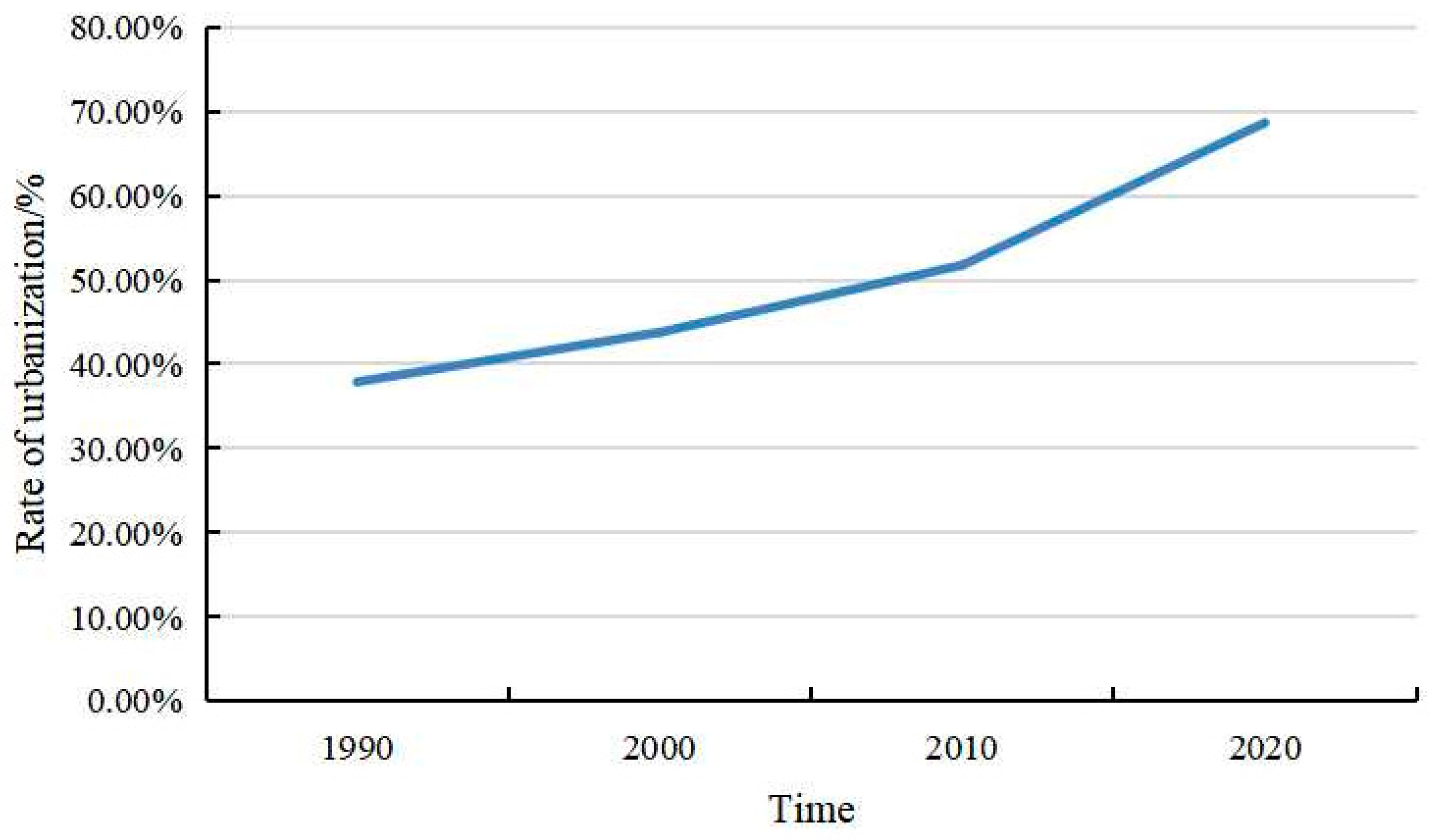
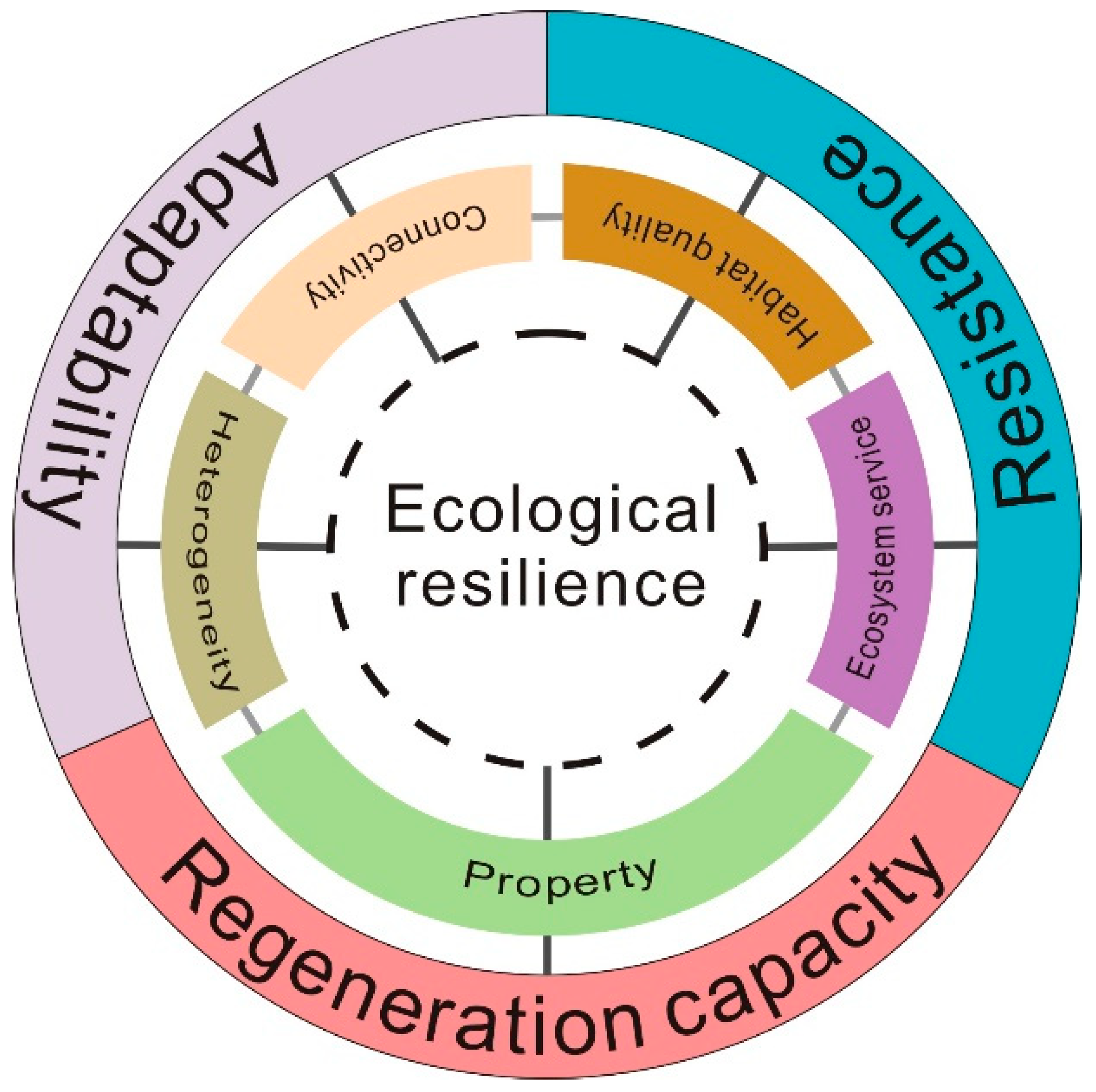
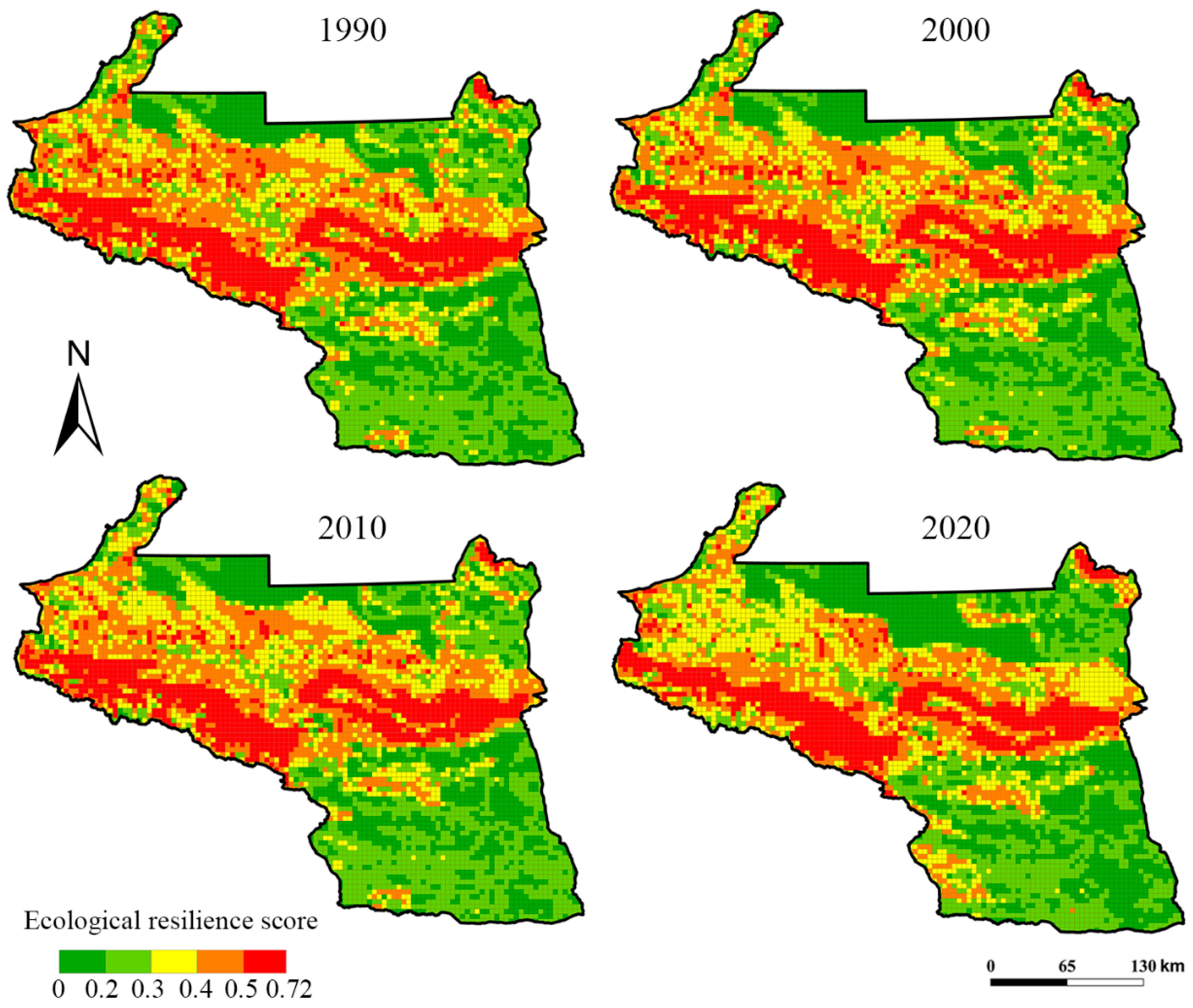

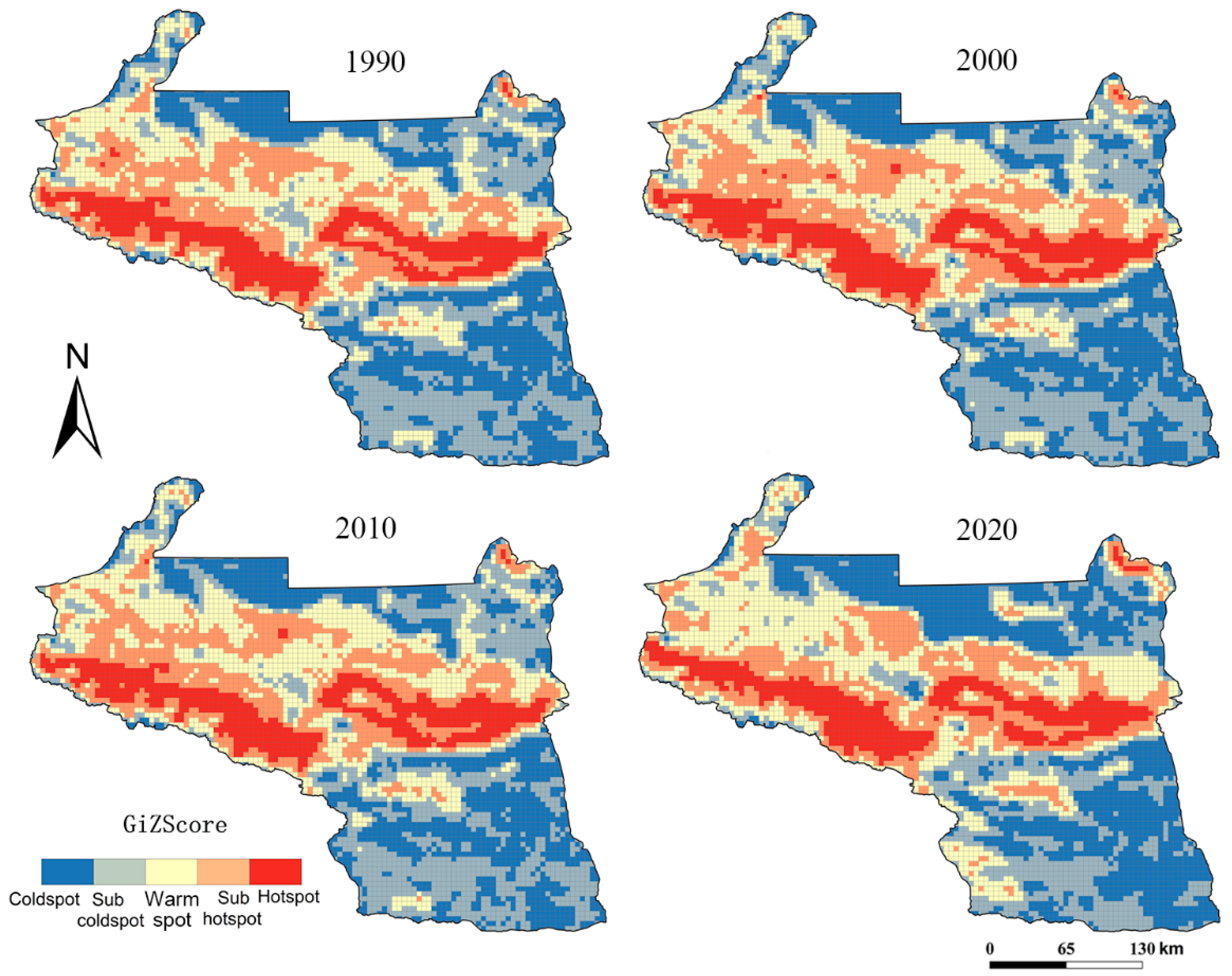
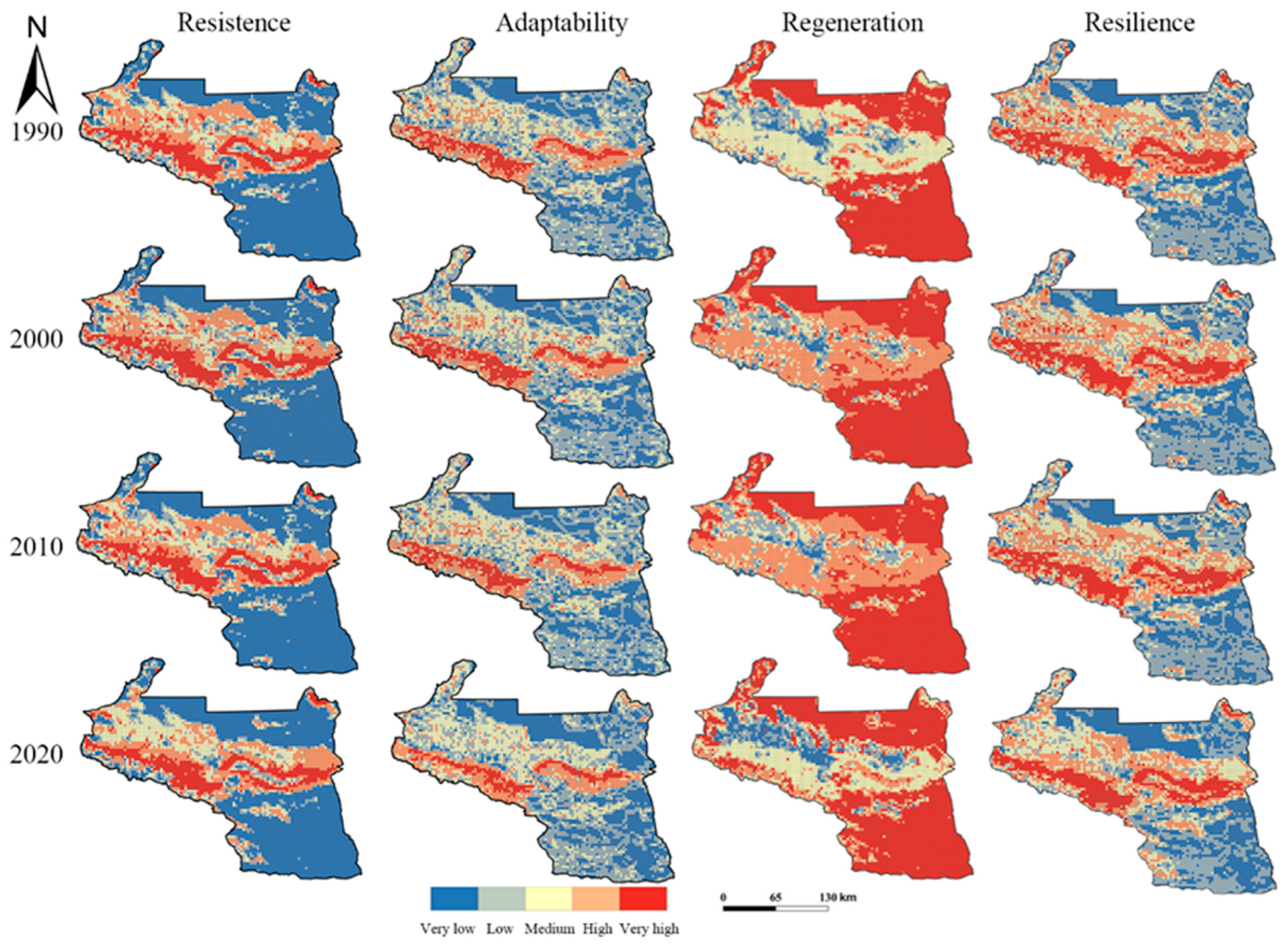
| Data Name | Time | Resolution Ratio | Source |
|---|---|---|---|
| Land-use | 1990, 2000, 2010, 2020 | 1 km | www.resdc.cn (accessed on 3 July 2022) |
| The digital elevation model (DEM), Slope | 2000, 2010, 2020 | 1 km | www.gscloud.cn (accessed on 13 September 2022) |
| Temperature, Precipitation | 2000, 2010, 2020 | 1 km | www.geodata.cn (accessed on 13 September 2022) |
| Highway, Railway | 2000, 2010, 2020 | \ | www.openstreetmap.org (accessed on 13 September 2022) |
| Nighttime lights [42] | 2000, 2010, 2020 | 1 km | www.geodoi.ac.cn (accessed on 25 September 2022) |
| Population density, GDP | 2000, 2010, 2020 | 1 km | www.resdc.cn (accessed on 13 September 2022) |
| Threat Source | Maximum Impact Distance/km | Weight | Decay |
|---|---|---|---|
| Arable land | 6 | 0.6 | Linear |
| Urban land | 10 | 0.9 | Exponential |
| Rural land | 8 | 0.7 | Exponential |
| Other construction lands | 6 | 0.6 | Exponential |
| Unused land | 4 | 0.4 | Exponential |
| Land-Use Type | Habitat Level | Crop | Urban | Rural | Others | Unused |
|---|---|---|---|---|---|---|
| Crop | 0.5 | 0 | 0.8 | 0.6 | 0.7 | 0.3 |
| Woodland | 1 | 0.8 | 0.9 | 0.8 | 0.8 | 0.5 |
| Shrub land | 0.9 | 0.7 | 0.8 | 0.7 | 0.7 | 0.4 |
| Sparse woodland | 0.8 | 0.6 | 0.7 | 0.7 | 0.6 | 0.5 |
| Other woodlands | 0.8 | 0.6 | 0.7 | 0.6 | 0.6 | 0.5 |
| High cover grassland | 0.9 | 0.6 | 0.7 | 0.7 | 0.7 | 0.6 |
| Medium cover grassland | 0.8 | 0.6 | 0.6 | 0.5 | 0.6 | 0.5 |
| Low cover grassland | 0.7 | 0.5 | 0.5 | 0.5 | 0.6 | 0.5 |
| Rivers and lakes | 1 | 0.6 | 0.9 | 0.7 | 0.5 | 0.4 |
| Reservoirs and beaches | 0.8 | 0.7 | 0.8 | 0.6 | 0.4 | 0.4 |
| Glaciers and permanent snowfields | 0.1 | 0.2 | 0.1 | 0.1 | 0.1 | 0.1 |
| Urban | 0 | 0 | 0 | 0 | 0 | 0 |
| Rural | 0 | 0 | 0 | 0 | 0 | 0 |
| Others | 0 | 0 | 0 | 0 | 0 | 0 |
| Sand, Gobi and Bare ground | 0.1 | 0.1 | 0 | 0 | 0 | 0 |
| Saline soil | 0.1 | 0.2 | 0.2 | 0.1 | 0 | 0 |
| Marshland | 0.4 | 0.6 | 0.6 | 0.5 | 0.4 | 0.3 |
| Ecosystem Services Function | Land-Use Types | ||||||
|---|---|---|---|---|---|---|---|
| Cultivated Land | Wood Land | Grass Land | Water Area | Permanent Snow Fields | Construction Land | Unused Land | |
| Food production | 2554.47 | 701.23 | 701.23 | 1968.44 | 0.00 | 0.00 | 30.05 |
| Raw materials | 1202.10 | 1612.82 | 1031.80 | 1096.92 | 0.00 | 0.00 | 90.16 |
| Water conservation | 60.11 | 831.45 | 571.00 | 16,348.60 | 6491.35 | 0.00 | 60.11 |
| Gas regulation | 2013.52 | 5289.25 | 3626.34 | 4012.02 | 540.95 | 0.00 | 330.58 |
| Climate regulation | 1081.89 | 15,827.69 | 9586.77 | 8850.48 | 1622.84 | 0.00 | 300.53 |
| Purify the environment | 300.53 | 4708.24 | 3165.54 | 13,749.05 | 480.84 | 0.00 | 931.63 |
| Hydrological regulation | 811.42 | 11,450.03 | 7022.28 | 190,037.42 | 21,427.48 | 0.00 | 631.10 |
| Soil formation and protection | 3095.41 | 6441.27 | 4417.73 | 4868.52 | 0.00 | 0.00 | 390.68 |
| Maintain nutrient circulation | 360.63 | 490.86 | 340.60 | 375.66 | 0.00 | 0.00 | 30.05 |
| Biodiversity protection | 390.68 | 5870.27 | 4017.03 | 15,657.39 | 30.05 | 0.00 | 360.63 |
| Recreational culture | 180.32 | 2574.50 | 1773.10 | 9947.40 | 270.47 | 0.00 | 150.26 |
| Level | Value Range | 1990 | 2000 | 2010 | 2020 | ||||
|---|---|---|---|---|---|---|---|---|---|
| Area | Proportion | Area | Proportion | Area | Proportion | Area | Proportion | ||
| 1 | 0–0.2 | 39,707.03 | 20.47% | 40,248.71 | 20.75% | 39,521.62 | 20.37% | 47,923.22 | 24.71% |
| 2 | 0.2–0.3 | 50,836.29 | 26.21% | 50,909.61 | 26.24% | 50,555.68 | 26.06% | 45,871.01 | 23.65% |
| 3 | 0.3–0.4 | 33,228.93 | 17.13% | 34,644.05 | 17.86% | 36,913.26 | 19.03% | 40,176.38 | 20.71% |
| 4 | 0.4–0.5 | 39,733.11 | 20.48% | 37,876.76 | 19.53% | 37,788.49 | 19.48% | 33,372.5 | 17.20% |
| 5 | 0.5–1 | 30,476.14 | 15.71% | 30,302.37 | 15.62% | 29,202.45 | 15.05% | 26,638.39 | 13.73% |
| Years | Gravity Center Coordinates (°E, °N) | Brachyaxis (km) | Macroaxis (km) | Azimuth (°) |
|---|---|---|---|---|
| 1990 | 87.97, 43.77 | 128.92 | 262.81 | 112.14 |
| 2000 | 87.98, 43.77 | 128.83 | 262.24 | 112.09 |
| 2010 | 87.98, 43.77 | 129.36 | 263.03 | 112.10 |
| 2020 | 87.99, 43.75 | 131.18 | 263.45 | 112.48 |
| Years | Influencing Factors | ||||||||
|---|---|---|---|---|---|---|---|---|---|
| Elevation | Slope | Temp | Precipitation | Population | GDP | Road Network | Nighttime Lighting | ||
| 2000 | q | 0.333 | 0.275 | 0.43 | 0.433 | 0.249 | 0.155 | 0.173 | 0.002 |
| p | 0.000 | 0.000 | 0.000 | 0.000 | 0.000 | 0.000 | 0.000 | 0.798 | |
| 2010 | q | 0.333 | 0.274 | 0.442 | 0.419 | 0.114 | 0.167 | 0.168 | 0.005 |
| p | 0.000 | 0.000 | 0.000 | 0.000 | 0.000 | 0.000 | 0.000 | 0.344 | |
| 2020 | q | 0.384 | 0.321 | 0.490 | 0.450 | 0.003 | 0.062 | 0.113 | 0.015 |
| p | 0.000 | 0.000 | 0.000 | 0.000 | 0.268 | 0.000 | 0.000 | 0.000 | |
| 2000 Influencing Factors | Elevation | Slope | Temp | Precipitation | Population | GDP | Road Net | Nighttime Lighting |
|---|---|---|---|---|---|---|---|---|
| Elevation | 0.333 | |||||||
| Slope | 0.407 | 0.275 | ||||||
| Temp | 0.520 | 0.467 | 0.431 | |||||
| Precipitation | 0.566 | 0.515 | 0.538 | 0.433 | ||||
| Population | 0.562 | 0.493 | 0.601 | 0.535 | 0.249 | |||
| GDP | 0.496 | 0.431 | 0.548 | 0.493 | 0.278 | 0.155 | ||
| Road network | 0.463 | 0.372 | 0.535 | 0.524 | 0.331 | 0.248 | 0.173 | |
| Nighttime lighting | 0.347 | 0.285 | 0.438 | 0.442 | 0.278 | 0.174 | 0.177 | 0.002 |
| 2010 Influencing factors | ||||||||
| Elevation | 0.333 | |||||||
| Slope | 0.406 | 0.274 | ||||||
| Temp | 0.520 | 0.485 | 0.442 | |||||
| Precipitation | 0.560 | 0.514 | 0.536 | 0.419 | ||||
| Population | 0.506 | 0.425 | 0.565 | 0.482 | 0.114 | |||
| GDP | 0.516 | 0.442 | 0.566 | 0.465 | 0.204 | 0.167 | ||
| Road network | 0.461 | 0.396 | 0.521 | 0.487 | 0.245 | 0.277 | 0.168 | |
| Nighttime lighting | 0.360 | 0.293 | 0.457 | 0.434 | 0.131 | 0.183 | 0.170 | 0.005 |
| 2020 Influencing factors | ||||||||
| Elevation | 0.384 | |||||||
| Slope | 0.461 | 0.321 | ||||||
| Temp | 0.531 | 0.527 | 0.490 | |||||
| Precipitation | 0.573 | 0.525 | 0.574 | 0.450 | ||||
| Population | 0.397 | 0.334 | 0.502 | 0.466 | 0.003 | |||
| GDP | 0.516 | 0.422 | 0.575 | 0.491 | 0.071 | 0.062 | ||
| Road network | 0.511 | 0.427 | 0.560 | 0.495 | 0.118 | 0.150 | 0.113 | |
| Nighttime lighting | 0.447 | 0.370 | 0.529 | 0.471 | 0.019 | 0.082 | 0.123 | 0.015 |
Disclaimer/Publisher’s Note: The statements, opinions and data contained in all publications are solely those of the individual author(s) and contributor(s) and not of MDPI and/or the editor(s). MDPI and/or the editor(s) disclaim responsibility for any injury to people or property resulting from any ideas, methods, instructions or products referred to in the content. |
© 2023 by the authors. Licensee MDPI, Basel, Switzerland. This article is an open access article distributed under the terms and conditions of the Creative Commons Attribution (CC BY) license (https://creativecommons.org/licenses/by/4.0/).
Share and Cite
Tong, Y.; Lei, J.; Zhang, S.; Zhang, X.; Rong, T.; Fan, L.; Duan, Z. Analysis of the Spatial and Temporal Variability and Factors Influencing the Ecological Resilience in the Urban Agglomeration on the Northern Slope of Tianshan Mountain. Sustainability 2023, 15, 4828. https://doi.org/10.3390/su15064828
Tong Y, Lei J, Zhang S, Zhang X, Rong T, Fan L, Duan Z. Analysis of the Spatial and Temporal Variability and Factors Influencing the Ecological Resilience in the Urban Agglomeration on the Northern Slope of Tianshan Mountain. Sustainability. 2023; 15(6):4828. https://doi.org/10.3390/su15064828
Chicago/Turabian StyleTong, Yanjun, Jun Lei, Shubao Zhang, Xiaolei Zhang, Tianyu Rong, Liqin Fan, and Zuliang Duan. 2023. "Analysis of the Spatial and Temporal Variability and Factors Influencing the Ecological Resilience in the Urban Agglomeration on the Northern Slope of Tianshan Mountain" Sustainability 15, no. 6: 4828. https://doi.org/10.3390/su15064828
APA StyleTong, Y., Lei, J., Zhang, S., Zhang, X., Rong, T., Fan, L., & Duan, Z. (2023). Analysis of the Spatial and Temporal Variability and Factors Influencing the Ecological Resilience in the Urban Agglomeration on the Northern Slope of Tianshan Mountain. Sustainability, 15(6), 4828. https://doi.org/10.3390/su15064828




